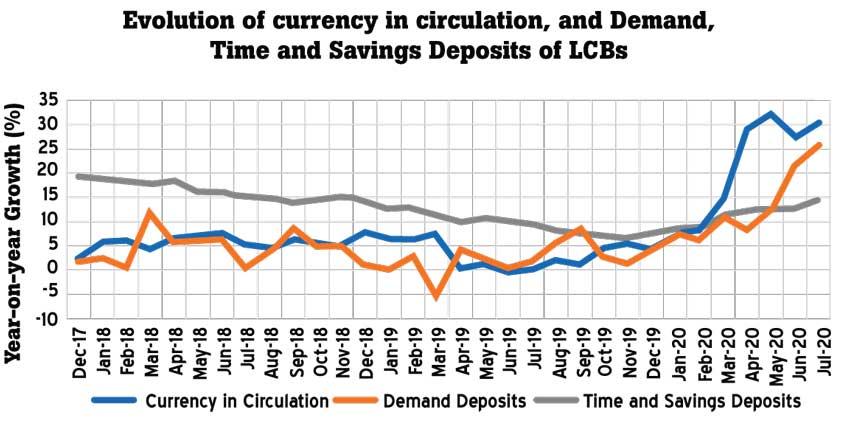11 Sep 2020 - {{hitsCtrl.values.hits}}

Sri Lankans have returned to save more during and in the immediate aftermath of the pandemic-induced lockdowns as they appeared to have become little more frugal in spending habits, restrained by the limited mobility and social distancing practiced to contain the virus spread.
According to data, both time and savings deposits and demand deposits—the proxy instruments to gauge how much money both individuals and businesses have set aside— have steadily risen from April to July, both on a year-on-year basis as well as on absolute basis.
The time and savings, which mostly consist of savings by wage earners, mom-and pop investors and by other businesses, have risen between12.4 and 14.1 percent, growing steadily every month from April through July, compared to the same period in 2019.
This is the highest since more than a year or February 2019 when such deposits rose by 12.4 percent over the same month in 2018. Since June 2019 till February 2020, Sri Lanka’s time and savings deposits grew by single digit between 6.4 percent and 9.9 percent before March 2020 logged 11.5 percent increase, but that has the effects of the depreciation on foreign currency denominated deposits when converted into rupees.
On absolute basis, Sri Lanka’s savings and time deposits have risen by a mammoth Rs.350 billion from April through July.
Meanwhile, the demand deposits, which mostly reflect the funds left by corporates in their bank accounts, also had their biggest increase during and in the aftermath of the strict lockdowns as businesses rushed for liquidity to ride the worst coming from the pandemic.
Such deposits rose to 8.2 percent in April, steadily rising up to 25.4 percent in July compared to the same period last year, reaching to a double-digit growth in many years.
This phenomenon was evident from the bank balance sheets from April to June which showed a significant increase in their deposit bases as opposed to the nascent growth in their loan books.
Salaried individuals left most of their earnings in savings accounts as they had limited spending options during lockdowns while companies preserved cash in their bank accounts so that they could use such funds to make the most after the effects of the
pandemic dissipate.
This pushed the liquidity levels in banks high as demand for loans didn’t catch up with the pace of deposit growth. But loan growth is coming back up, quite rapidly, as seen from the gross loan disbursements by banks and the private sector credit data for July.
Sri Lanka’s total outstanding time and savings deposits rose from Rs.7,133 billion to Rs.7,483 billion by the end-July, while the outstanding total demand deposits rose from Rs.397 billion to Rs.432 billion.
However, it is uncertain as to how long the current trend in savings could last as people resume spending when they feel safe to go places, watch movies, dine out, and engage in other recreational activities, which they temporarily put off during the virus-led lockdowns.
Meanwhile, companies could restart spending their moneys on new investments and resume projects, which were temporarily halted, as they begin to build confidence in the economy and policies with the disappearance of virus fears and restoration of political stability.
On the other hand, currency in circulation in the country has soared as a result of government’s stimulus money and other government spending during and in the aftermath of the pandemic, which was aimed at keeping economic activities humming.
According to data, the currency in circulation rose between 28.9 percent and 30.5 percent from April through July compared to the comparable months in 2019, reaching record levels in years, in terms of year-on-year growth.
18 Nov 2024 4 hours ago
18 Nov 2024 5 hours ago
18 Nov 2024 5 hours ago
18 Nov 2024 5 hours ago
18 Nov 2024 5 hours ago